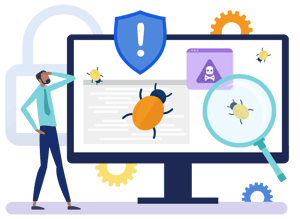Incident Response Management
When an incident occurs, there's often uncertainty about the severity and potential impact on the organization. Knowing that there's a structured approach in place reduces stress and anxiety, fostering a sense of control during a potentially chaotic situation.

Navigating Cyber Crisis Management
Incident response plans are not one-size-fits-all. Get a customized plan that aligns with your industry regulations, business objectives, and specific security needs.
START MY JOURNEY!
Cyber threats evolve rapidly, and incidents can escalate swiftly. The pressure to respond efficiently in the face of a rapidly unfolding situation can be overwhelming. Having a well-structured incident response plan can help.
Book a meeting to learn more about partnering with SBS.
Incident Response Planning
Partner with SBS to ensure that your well-structured Incident Response Plan (IRP) will help mitigate the negative effects of a security breach. It will also demonstrate to examiners that your organization is well-prepared to handle such an event.
Engagement
Deliverables
REQUEST A QUOTE!
We are excited to have the opportunity to help you find the perfect solution that meets all of your needs.
Active Incident Response
When crisis strikes, the last thing you want is hesitation or uncertainty when asked, “What do we do now?”- Rapid response time
- Fast-track scoping call based on IR plan
- Recommendations for legal and other resources during response
- Elastic Response Framework
- In-depth digital forensics analysis
- Comprehensive data and system restoration
- Proven threat actor communications strategies

Active Incident Response
Please contact us if you need assistance with a potential or active incident.
50+ Incident Response Preparedness Checklist Items
The #1 question organizations need to ask themselves is “if someone was in our network, would we know?”
The ability to answer that single, extremely important question makes all the difference between being able to respond and recover from an incident quickly and cost-effectively vs. being notified by a user, or worse yet, by a federal agency, that something is amiss.
If you are uncertain how to go about preparing for and detecting an incident on your network, you are not alone. This list contains over 50 incident response preparedness items that should be prepared ahead of time.


Certified Banking Incident Handler
This course will provide you with an increased understanding of the best practices related to handling common incidents in the banking industry and minimizing losses.
Hear What Our Clients Say!
⭐⭐⭐⭐⭐ 09/04/2024
"We contracted with SBS for a couple of reasons; we use them for IT/Cyber audits such as Network Security Assessments, IT Controls, Tabletop Testing, annual Training, M365 reviews, and Wireless penetration testing. We also use their TRAC software for all our policies and risk assessements as well as tracking action items from audit findings. Along with the TRAC software we invested in consulting services that continue help keep our program on track and up to the latest requirements."
⭐⭐⭐⭐⭐ 09/04/2024
"If you are looking for a company that has the knowledge and skill of a huge corporation with the service of a local "hometown" business, this is it! I can't say enough about the employees and their willingness to help in any situation. I've been through a certification course as well as utilize SBS for services and I have never been disappointed. In fact, they are probably one of the vendors that I couldn't do without in my position as ISO. The company and the employees are a pleasure to work with."
⭐⭐⭐⭐⭐ 09/30/2024
"If you're looking for a fully managed service to support your vendor reviews, SBS CyberSecurity fills that gap. The team is responsive and a pleasure to collaborate with, especially with the knowledge and experience they bring to the table. Having them as an extension of the team ensures that we meet regulatory demands and allocate our resources to other critical tasks. Thank you!"
SBS CYBERSECURITY IS AN EXCELLENT CUSTOMER TO WORK WITH!!
Heather B.
⭐⭐⭐⭐⭐ 10/26/2023
"Everyone that we have worked with at SBS CyberSecurity is very knowledgeable about the topics they are helping us with. They are more than willing to provide you data to help in any decision-making situations."
SBS CYBERSECURITY IS A TRUSTED PARTNER FOR US!
Shauna E. | Small-Business
⭐⭐⭐⭐⭐ 11/08/2023
"Everyone at SBS CyberSecurity has the necessary industry knowledge to support our credit union and its needs. Their customer support is top-notch. They are always available and follow through with what they say they will do. The various modules that SBS offers relate to our business needs."
SBS PROVIDES SUPERIOR IT AUDITS AND TESTING
Jeff V. | Small-Business
⭐⭐⭐⭐⭐ 11/28/2023
"The depth of testing they provide is like nothing I've seen from other vendors. We've always done external penetration testing and internal vulnerability scans, but SBS takes it a step further to show security gaps which were not discovered in the past. We've reached out to them long after the audit was completed and they were very helpful with any questions or clarification we had."
SBS CYBERSECURITY PROVIDES AND INVALUABLE SERVICE FOR SMALL BANKS
Kim P. | Banking
⭐⭐⭐⭐⭐ 11/14/2023
"I did not have to re-create the wheel to develop a comprehensive Information Security Program. The TRAC software has all the components, including policies, that are easy to use! I like how the program separates the requirements into different modules, as this is much easier to implement, but the end product integrates these modules and documents it into a comprehensive program that is usable."
FANTASTIC CUSTOMER SERVICE
Verified User in Banking | Small-Business
⭐⭐⭐⭐⭐ 11/09/2023
"I have enjoyed working with our assigned consultant, but I have had the opportunity to work with numerous employees throughout SBS and all of them have been friendly, professional, and offered exceptional customer service. Kudos to SBS for building a strong, exceptional environment for their employees to thrive in."
SECURITY TESTING WITH THE BEST
Jessica R. | Mid-Market
⭐⭐⭐⭐⭐ 11/09/2023
"SBS CyberSecurity performed my security penetration audit on our hospital's network this year. Our consultant provided excellent assistance with gathering information to perform the test as well as providing solutions that we were able to implement. They helped us recognize a flaw where the outside guest wifi could access the internal network which we were quickly able to stop with their assistance while the test was being performed."

.png?width=400&name=SBSIWebinarsBundles_WebMenu%20(1).png)